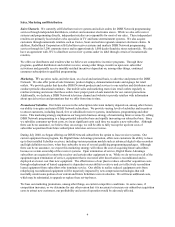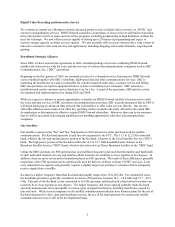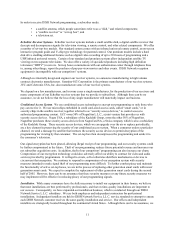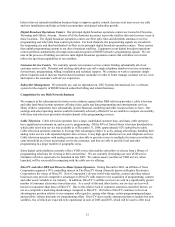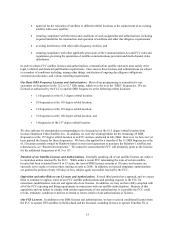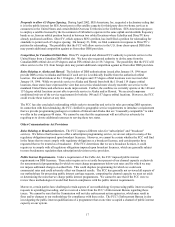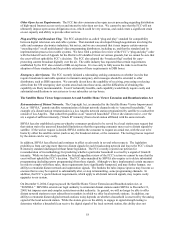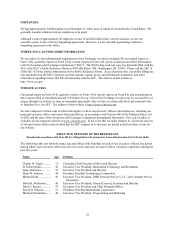Dish Network 2004 Annual Report Download - page 20
Download and view the complete annual report
Please find page 20 of the 2004 Dish Network annual report below. You can navigate through the pages in the report by either clicking on the pages listed below, or by using the keyword search tool below to find specific information within the annual report.12
believe that our internal installation business helps to improve quality control, decrease wait time on service calls
and new installations and helps us better accommodate anticipated subscriber growth.
Digital Broadcast Operations Centers. Our principal digital broadcast operations centers are located in Cheyenne,
Wyoming and Gilbert, Arizona. Almost all of the functions necessary to provide satellite-delivered services occur at
those locations. The digital broadcast operations centers use fiber optic lines and downlink antennas to receive
programming and other data from content providers. For local channels, the programming signals are encoded in
the originating city and then backhauled via fiber to our principal digital broadcast operation centers. These centers
then uplink programming content to our direct broadcast satellites. Equipment at our digital broadcast operations
centers performs substantially all compression and encryption of DISH Network’s programming signals. We are
also in the process of building several new mini digital broadcast operations centers that will allow us to better
utilize the spot beam capabilities of our satellites.
Customer Service Centers. We currently operate ten customer service centers fielding substantially all of our
customer service calls. Potential and existing subscribers can call a single telephone number to receive assistance
for hardware, programming, billing, installation and technical support. We continue to work to automate simple
phone responses and to increase Internet-based customer assistance in order to better manage customer service costs
and improve the customer’s self-service experience.
Subscriber Management. We presently use, and are dependent on, CSG Systems International, Inc.’s software
system for the majority of DISH Network subscriber billing and related functions.
Competition for our Dish Network Business
We compete in the subscription television service industry against other DBS television providers, cable television
and other land-based system operators offering video, audio and data programming and entertainment services.
Many of these competitors have substantially greater financial, marketing and other resources than we have. Our
earnings and other operating metrics could be materially adversely affected if we are unable to compete successfully
with these and other new providers of multi-channel video programming services.
Cable Television. Cable television operators have a large, established customer base, and many cable operators
have significant investments in, and access to, programming. Of the 99% of United States television households in
which cable television service was available as of December 31, 2004, approximately 62% subscribed to cable.
Cable television operators continue to leverage their advantages relative to us by, among other things, bundling their
analog video service with expanded digital video services, 2-way high speed internet access, and telephone services.
Cable television operators with analog systems are also able to provide service to multiple television sets within the
same household at a lesser incremental cost to the consumer, and they are able to provide local and other
programming in a larger number of geographic areas.
Some digital cable platforms currently offer a VOD service that enables subscribers to choose from a library of
programming selections for viewing at their convenience. We are currently developing our own VOD service
alternative which is expected to be launched in late 2005. We cannot assure you that our VOD service, when
launched, will be successful in competing with the cable service offering.
DirecTV and other DBS and Direct-to-Home System Operators. During December 2003, an affiliate of News
Corporation acquired a 34% controlling interest in The DirecTV Group (formerly known as Hughes Electronics
Corporation), the owner of DirecTV. News Corporation’s diverse world-wide satellite, content and other related
businesses may provide competitive advantages to DirecTV with respect to the acquisition of programming, content
and other assets valuable to our industry. In addition, DirecTV’s satellite receivers are sold in a significantly greater
number of consumer electronics stores than ours. As a result of this and other factors, our services are less well
known to consumers than those of DirecTV. Due to this relative lack of consumer awareness and other factors, we
are at a competitive marketing disadvantage compared to DirecTV. We believe DirecTV continues to be in an
advantageous position relative to our company with regard to, among other things, certain programming packages,
and possibly, volume discounts for programming offers. DirecTV also recently announced plans to launch four new
satellites, two of which are expected to be operational in each of 2005 and 2007, which will be used to offer local




